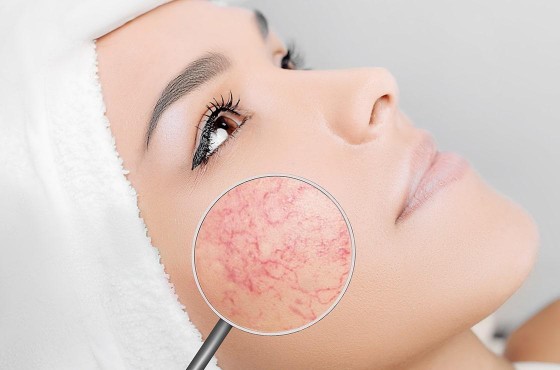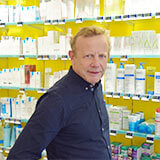Rosacea:
how can its intensity be limited?
Written by Paul Musset, Doctor in Pharmacy | published on | updated on 15/04/2024

Rosacea is a common skin disease that causes redness mainly on the face and affects women from the age of 30 for the most part. Depending on its extent, this dermatological condition, which is often confused with acne, can be very difficult for the person suffering from it. How does rosacea appear? Are there any triggering or aggravating factors? Is there a way to get rid of it?
Rosacea: Explanations and causes
Rosacea: A common skin disease not to be confused with acne
Rosacea is a skin condition that causes redness on the skin of the face. The primarily affected areas are the cheeks and the nose. Then come the forehead and chin.
Rosacea can sometimes be confused with acne. However, it is quite different. Indeed, in its papulopustular form, it is also called acne rosacea because the spots of both dermatological disorders are similar. However, rosacea is characterised by a more diffuse redness, subject to periods of severe flare-ups, and it mostly affects adults. Moreover, this dermatological condition is chronic and progressive, unlike acne, which tends to decrease with age.
Who is affected?
Women with fair skin most likely to be affected
It is mainly individuals with fair skin who are most likely to suffer from rosacea. Populations with Scandinavian, Irish or Scottish heritage are therefore at greater risk of developing rosacea. Furthermore, hereditary factors may also come into play.
Finally, this dermatological disease mainly affects women. On average, 2 to 3% of adults are concerned, with two women affected for every man.
A disease that evolves over time
Rosacea usually appears from the age of 30. At the beginning of the disease, the frequency of symptoms is relative, but it increases gradually.
Periods of flare-ups become more frequent and, without treatment, complications can occur, particularly regarding the eyes, as the cornea may be affected. This stage of rosacea requires medical advice.
Triggering or aggravating factors
Although the origins of rosacea have not yet been clearly identified by specialists, the causes may be linked to:
- Genetics
- The environment
- An abnormal reaction of the blood microvessels in the presence of heat
- The existence of mites on the face called demodex
At the same time, many factors can contribute to the occurrence or aggravation of rosacea:
- Hormonal changes related to pregnancy or menopause
- The sun
- Taking corticosteroids
- Some histamine-rich foods such as tomatoes, nuts, citrus fruits
- Alcohol
- Spices
- Coffee, tea or any other hot drink
- Stress
Rosacea: 6 ways to limit its intensity
Adapt your beauty ritual
Skin with rosacea requires special care to avoid flare-ups. The main objective is not to attack the skin with products that are too irritating. In the morning, proper hydration is essential to protect the epidermis from external aggressions. Since the sun tends to exacerbate redness, protection from the sun, even in cities and in winter, is helpful.
As for skincare, serums or creams with soothing and anti-inflammatory active ingredients should be preferred. In the evening, even if there is no make-up on the skin, it is essential to use a cleansing milk or a mild soap-free cleanser to remove pollution-related impurities.
It is preferable to rinse the skin with warm water to limit tight pulling sensations. As for drying the skin, to avoid accentuating redness by rubbing, it is preferable to pat the face gently with a tissue.
Review your lifestyle and diet
As we have seen above, rosacea may be linked to lifestyle factors. Reviewing your eating habits may help slow rosacea flare-ups.
Redness treatments
The purpose of redness treatments is to limit the dilation of blood vessels while protecting the skin from aggressors.
At Cocooncenter, we offer you a wide range of effective products to treat rosacea-related redness. We have selected solutions from leading brands that are designed for skin with a tendency for rosacea, such as the Redness-Relief Cream from Avène. This moisturising emulsion provides the skin with comfort and protection for better control of facial redness.
Make-up tips to hide rosacea
Women with rosacea naturally need to hide this unsightly redness and its associated marks.
To help them re-establish a uniform and natural complexion, Cocooncenter offers a wide selection of CC creams. These tinted emulsions combine skincare and make-up, the winning duo for an everyday radiant glow that exudes health.
Did you know?
Many redness treatments have a slightly green tint. Far from being a coincidence, these green pigments play a key role in concealing redness. Indeed, the two colours are complementary. Combined, they magically cancel each other out.
Home remedies
Putting aside cosmetic products, our grandmothers left us with a few unsuspected tricks to fight redness. Here are two recipes you can try at home:
Clay and lemon
- Soak a cotton pad in clay water and apply it to the redness
- Pass the inside of a lemon rind over the skin
Oatmeal
Its anti-inflammatory properties make it a powerful ally in the fight against rosacea. For good effectiveness, here is how you should proceed:
- Add 2 tablespoons of oatmeal to a 1/4 litre of water
- After mixing well, use a damp cotton pad to apply this mixture
- Leave on for 5 minutes
- Rinse
Laser
In cases of vascular rosacea, laser treatment is possible. This is usually done by a specialised doctor or dermatologist. The sessions last between 5 and 20 minutes. The duration of the treatment and the frequency of the sessions vary depending on the patient’s individual circumstances (light or dark skin, level of rosacea). In all cases, the advice of the practitioner should be followed.
Rosacea often makes life difficult for those who suffer from it, as it mainly affects the face and can cause discomfort and profound suffering. Although this dermatological condition remains incurable to this day, it is entirely possible to reduce its progression and reduce redness. Reviewing your lifestyle and adapting your skincare routine are the first steps you should take if you suffer from rosacea.
Three key points to remember about rosacea:
- Women over the age of 30 are those most commonly affected by rosacea.
- The sun exacerbates redness.
- There is no complete cure. It is only possible to reduce the symptoms.






















